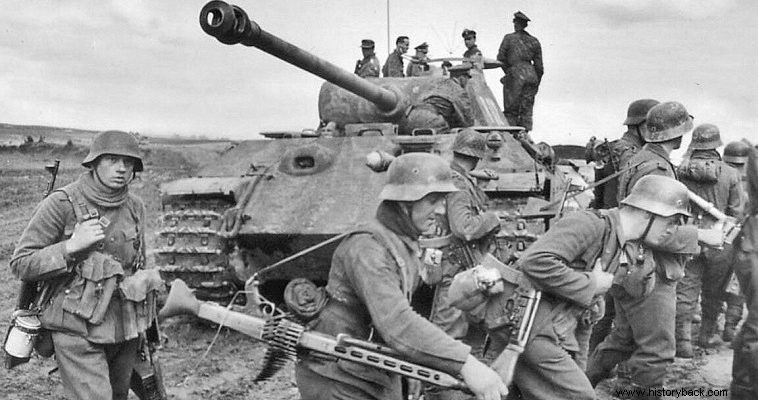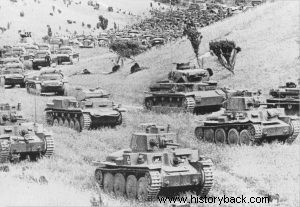
The 7th Panzer Division (Panzer Division) was one of the most famous of the German army in World War II. This is due to its exceptional action in France in 1940 when its commander was the also famous Erwin Rommel. However, the 7th Infantry Division performed equally impressively in the fierce battles of the Eastern Front.
The 7th Infantry Division was "born" in 1938 as the 2nd Light Division (EM). When formed in Thuringia it had a single tank division (66th Division), the 6th and 7th Motorized Cavalry Regiments, the 7th Reconnaissance Regiment, the 78th Artillery Regiment (two squadrons), the 58th Engineer Battalion, the 42nd Anti-Tank Battalion, a forward company and anti-aircraft gunnery.
It is worth noting that the 66th Division had only Pz I and Pz II light tanks , armed the former with two machine guns, the latter with a 20mm light cannon and a machine gun.
With this composition, the 2nd EM participated, integrated into the 10th Army, took part in the attack against Poland. He performed well in the operation to break through the Polish defenses at the Warta River and then took part in dealing with the Polish counter-attack at Bzura and then to the attack on Warsaw.
The 2nd EM remained in Poland until October 1, 1939, when it returned to Germany where began its conversion to the BA . The 7th Army, as it was now called, had the 25th Panzer Regiment with three divisions, one of which was the old 66th.
Transformation and glory in France
The 25th was supplied with 104 obsolete tanks (72 Pz II and 32 Pz I) and Czechoslovak-designed Pz 38(t) light tanks called "Praga" . These tanks had a 37mm gun and were roughly the same as the early models of the German Pz III. The 7th Army had only 23 Pz IV medium tanks.
Also cavalry regiments were converted into "hunter" regiments (mounted infantry), each with a strength of two battalions. Together they formed the 7th Infantry Brigade.
The 7th Reconnaissance Regiment was disbanded and replaced by the 7th Reconnaissance Battalion and the 7th Reconnaissance Brigade. She was also assigned the 83rd Transmission Battalion. With this composition it operated in France where it was given the nickname "Ghost Division" . Breaking the French front at Dinan, the division, under the dashing Rommel, advanced at breakneck speed, sweeping away all French resistance before it.
He captured over 10,000 French prisoners and destroyed or captured over 100 French tanks, 30 other armored vehicles, 27 field guns, in the initial phase of the battle , at a cost of 35 dead and 50 wounded.
In total the division captured 97,468 prisoners, destroyed or captured on the ground 67 French aircraft, 277 guns, 64 anti-tank guns, 458 tanks and armored vehicles and at least 5,500 other vehicles. She herself had 682 dead, 1,643 wounded and 285 missing in the Battle of France while also losing 42 tanks.
Soviet Union
In view of the attack on the USSR, the 7th Army was transferred to East Prussia for reorganization. At the start of the attack, he rushed forward like an arrow, inflicting terrible losses on the Soviets, despite the superiority of the latter in tank strength. The division's 78th Artillery Regiment alone destroyed 263 Soviet tanks.
By November 15 the division had lost just 1,100 men. But the Russian winter and the Soviet counterattack changed everything. By January 1942 the division's infantry had lost almost 60% of its original strength.
And tank losses were appalling. At one point the division found itself with only 5 tanks available. By January 23rd the division had lost 9,000 of its original 14,400 men!
In the spring of 1942 the division was sent to France to replenish losses and regroup. Again, however, she was not provided with heavy armor. The best tanks available to her were 35 Pz III Ausf J and 30 Pz IV Ausf G.
At the same time the staff of the 7th Infantry Brigade was abolished and its two mounted regiments were renamed Panzer Grenadier regiments. Under its new composition the division took part in the occupation of Vichy France by the Germans and was then sent back to the Eastern Front.
From Kursk to Berlin
The 7th Army was initially sent to the southern edge of the German front which was reeling from the debacle at Stalingrad. The division had only 95 tanks. Nevertheless, between January and February it destroyed 254 Soviet tanks, 300 guns of all types and over 400 other vehicles, losing 12 of its own tanks.
He then took part in the German attack on the Kursk enclave suffering terrible losses. This happened a little later in Kyiv and Tarnopol where he was surrounded. He escaped the line but was now left with nine tanks, nine guns, 11 anti-tank guns and 1,872 men.
Despite this he continued to fight in the face of the great Soviet summer offensive in 1944. He then fought at Memel and was then transported by ship to East Prussia. There she lost, fighting, all her material. Elements of it were transferred to northern Pomerania and participated in the final battle, in Berlin.
Most of her men managed to escape Soviet captivity. The division was officially handed over to the British on May 3, 1945 in Schwerin, on the border between Germany and Denmark. In addition to Rommel, its famous commanders were the later last German general in Africa Georg Stumme and the ace of the panzers, Hasso von Madeufel .

Pz IV, Pz 38(t), Pz II and various vehicles of the 7th Army in France in 1940.
